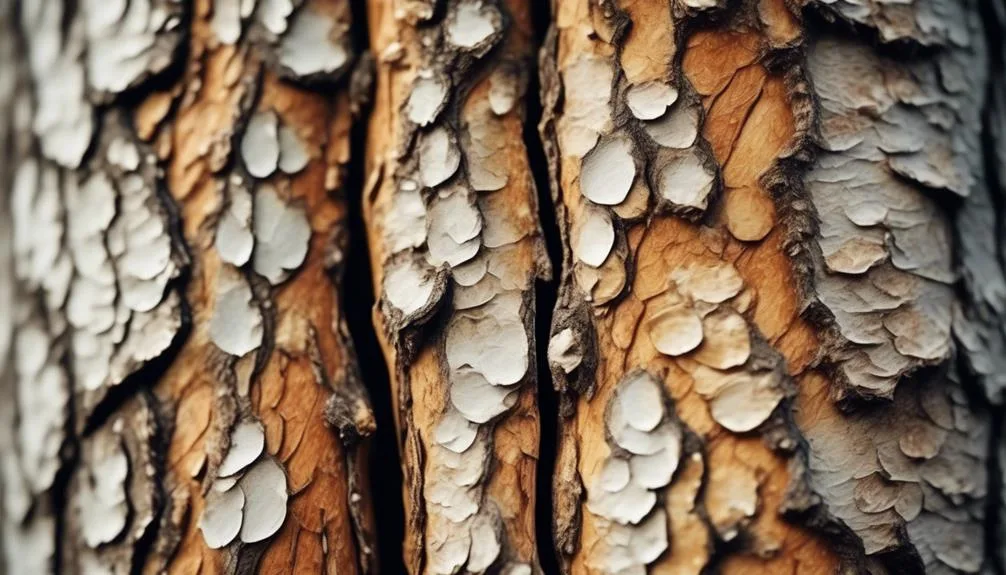Have you ever noticed the striking spotted bark on sycamore trees while walking through a forest? The unique patterns on their trunks have intrigued nature lovers for years.
What causes this distinct feature? The answer is more fascinating than you might expect.
Join us as we explore the captivating reasons behind the spotted bark of sycamore trees and its intriguing role in their lives.
Sycamore Tree Bark Characteristics
If you take a closer look at the sycamore tree bark, you'll notice distinct characteristics that set it apart from other tree barks. Sycamore bark patterns are truly unique, often described as mottled or patchy, with a mix of light and dark spots. These patterns resemble camouflage and make sycamores easily identifiable, even from a distance.
The bark's color varies from pale white to light green when young, gradually transforming into shades of gray as the tree matures. When identifying a sycamore, the bark is a key feature to look for, as it remains consistent regardless of the season.
These distinct bark patterns not only aid in tree identification but also add to the aesthetic appeal of sycamores, making them a standout feature in any landscape.
Causes of Sycamore Tree Bark Spots
The spotted bark on sycamore trees is caused by a natural phenomenon known as exfoliation, which results in the shedding of old bark to reveal the lighter, inner layers. This process is influenced by various factors, including fungal infections and the overall health of the tree.
- Fungal Infections
Certain fungal infections can lead to discoloration and spotting on sycamore tree bark. These infections can weaken the bark, making it more susceptible to exfoliation and creating the characteristic spots.
- Tree Health
The overall health of the sycamore tree plays a crucial role in the development of bark spots. Trees that are stressed or in poor health are more prone to fungal infections and exfoliation, resulting in a greater prevalence of spotted bark.
Understanding these causes is essential for maintaining the health and vitality of sycamore trees in natural and cultivated environments.
Role of Fungus in Sycamore Bark Spots
One of the key factors contributing to the development of spotted bark on sycamore trees is the role played by various fungi present in the tree's environment. Fungal symbiosis with sycamore trees is a complex and essential aspect of their ecosystem. Certain fungi, like anthracnose, create distinct spots on the bark as part of their life cycle. These spots are not just blemishes; they also indicate a delicate equilibrium within the tree. The fungi and the tree engage in a mutually beneficial relationship, contributing to the overall health and vitality of the sycamore. This symbiotic relationship helps the tree combat pathogens, absorb essential nutrients, and may even contribute to the tree's resilience in the face of environmental stressors.
| Fungi | Role in Sycamore Bark Spots |
|---|---|
| Anthracnose | Creates distinct spots as part of its life cycle |
| Symbiosis | Contributes to tree health and vitality |
| Nutrient absorption | Assists the tree in absorbing essential nutrients |
| Pathogen resistance | Aids the tree in combatting pathogens |
Environmental Factors Affecting Sycamore Bark
Amidst the lush greenery and towering stature of sycamore trees, an array of environmental factors intricately shapes the distinctive patterns and health of their bark.
The climate plays a pivotal role in the development of sycamore bark, with varying levels of moisture and temperature affecting the rate of growth and the appearance of the bark.
Additionally, the soil composition directly impacts the availability of essential nutrients for the trees, influencing the overall health and resilience of their bark. Different soil types can lead to variations in bark patterns and colors, creating a diverse visual landscape within sycamore groves.
Understanding how climate and soil composition interact with sycamore trees provides valuable insight into the intricate relationship between these environmental factors and the unique characteristics of their bark.
Significance of Spotted Bark for Sycamore Trees
Exploring the significance of spotted bark for sycamore trees reveals the remarkable ways in which environmental factors, such as climate and soil composition, manifest in the unique patterns and health of their bark. The spotted bark serves multiple important purposes for sycamore trees, including adaptation, growth, and defense. Here's a closer look at the significance of the spotted bark for these majestic trees:
| Importance | Adaptation | Growth | Defense |
|---|---|---|---|
| Provides insulation | Blends into varied | Facilitates | Protects against |
| environments | nutrient uptake | pests and diseases | |
| Reflects excess | Adapts to | Promotes | Strengthens |
| sunlight | changing conditions | healthy growth | resistance |
| against damage |
The spotted bark not only enhances the visual appeal of sycamore trees but also plays a crucial role in their overall health and vitality.
Conclusion
Intriguingly, the spotted bark of the sycamore tree serves as a testament to its resilience and the intricate balance of nature.
Through environmental factors and fungal activity, the tree's bark plays a vital role in safeguarding its well-being.
This emphasizes the sycamore's significance within the ecosystem, prompting us to ponder the interconnectedness of all living organisms.
Mark Hoffman is a dedicated arborist and tree care specialist with over a decade of experience. His love for trees began when he visited Yosemite National Park as a teenager and was awestruck by the giant sequoias. Mark pursued his passion by studying forestry at Michigan Technological University, where he earned a Bachelor of Science degree.
Since then, he has worked tirelessly in the field of arboriculture, helping to preserve and protect trees in his community. His expertise and dedication have made him a respected leader in the industry and a valuable resource for anyone seeking advice on tree care.
